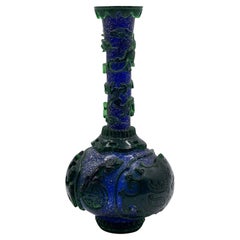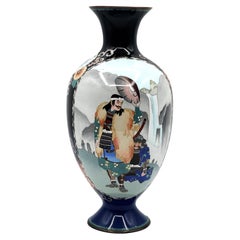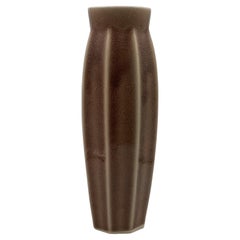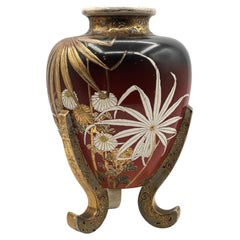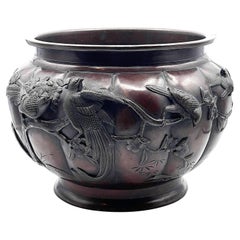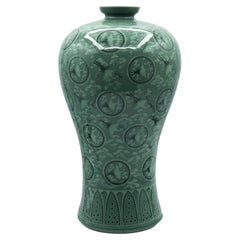Ashville Fine Arts Vases and Vessels
to
1
43
1
7
35
26
4
5
18
3
4
1
1
2
1
3
13
4
1
1
21
16
11
9
5
43
24
24
20
16
9
Height
to
Width
to
43
43
43
1
1
1
1
1
Chinese Green and Blue Peking Cut Glass Vase with Thin long Neck, Ca. 1910
Located in New York, NY
Chinese Green and Blue Peking Cut Glass Vase with
Thin long Neck, Ca. 1910
MARKINGS
Signed on t...
Category
Early 20th Century Chinese Vases
Materials
Glass
Japanese Meiji Period Cloisonné Vase with Samurai and Floral Motif, Ca. 1890
Located in New York, NY
Japanese Meiji Period Cloisonné Vase w/ Samurai, Attendant, and Floral Motif, Ca. 1890
DIMENSIONS:
Height: 12 inches
Diameter: 5.5 inches
ABOUT
An elegant cloisonné enamel vase fr...
Category
Antique 1890s Japanese Japonisme Vases
Materials
Porcelain
Japanese Modernist Beige Studio Ceramic Flower Vase, Circa 1950s
Located in New York, NY
Japanese Modernist Beige Studio Ceramic Flower Vase, Circa 1950s
DIMENSIONS:
Height: 11 inches
Diameter: 4 inches
ABOUT JAPANESE MODERNIST BEIGE STUDIO CERAMICS
Japanese Modernist...
Category
Vintage 1950s Japanese Japonisme Vases
Materials
Ceramic
Japanese Late Meiji Period Satsuma Three-Footed Vase, Ca. 1900
Located in New York, NY
Japanese Late Meiji Period Satsuma Three-Footed Vase, Ca. 1900
Late Meiji Period (1868-1912)
DIMENSIONS:
Height: 10.25 inches
Di...
Category
Antique Early 1900s Japanese Japonisme Vases
Materials
Porcelain
Japanese Edo Period Bronze Jardinière w/ Birds & Cherry Blossom Tree, 19th C.
Located in New York, NY
#350
Japanese Edo Period Bronze Jardinière w/ Birds & Cherry Blossom Tree, 19th C.
DIMENSIONS:
Height: 9 inches
Diameter: 12 inches
DETAILS
Edo Period (1603-1868) Meiji Period (...
Category
Antique Mid-19th Century Japanese Japonisme Planters, Cachepots and Jard...
Materials
Bronze
Korean Meiping Green Porcelain Flower Vase, Early 20th Century
Located in New York, NY
Korean Meiping Green Porcelain Flower Vase, Early 20th C
DETAILS
Signed on the bottom.
DIMENSIONS:
Height: 14 inches
Diameter: 7.5 inches
ABOUT VASE
This very elegant Meiping vase...
Category
Vintage 1910s South Korean Japonisme Vases
Materials
Porcelain
Japanese Meiji Period Koransha Olive Green & Gold Glaze Porcelain Vase, Ca. 1880
Located in New York, NY
Japanese Meiji Period Koransha Olive Green & Gold Glaze Porcelain Vase, Ca. 1880
DIMENSIONS
Height: 4.5 inches
Diameter: 5 inches
ABOUT
Meiji Period (1868–1912) Koransha Porcelain ...
Category
Antique Early 1800s Japanese Japonisme Vases
Materials
Porcelain
Chinese Peking Cut Blue & White Cameo Glass Vase, Ca. ca. 1900-1920
Located in New York, NY
Chinese Peking Cut Blue & White Cameo Glass Vase, Ca. ca.1900-1920
DIMENSIONS:
Height: 12.5 inches
Diameter: 5.5 inches
ABOUT CHINESE PEKING GLASS
Peking cut blue ...
Category
Vintage 1910s Japanese Japonisme Vases
Materials
Glass
Japanese Meiji Period Porcelain Vase by Shimazu Gyokuzan, Ca. 1890
Located in New York, NY
Japanese Meiji Period Porcelain Vase by Shimazu Gyokuzan, Ca. 1890
DIMENSIONS
Height: 18.5 INCHES
Diameter: 9 inches
DETAILS
Meiji Period (1868 -1912) – Ca.18...
Category
Antique 1890s Japanese Japonisme Vases
Materials
Porcelain
Chinese Art Deco Famille-Rose Vase with Flower and Dragon Motif, Ca. 1920
Located in New York, NY
Chinese Art Deco Famille-Rose Vase with Flower and Dragon Motif, Ca. 1920
DIMENSIONS
Height: 24 inches
Diameter: 10 inches
Category
Vintage 1920s Chinese Japonisme Vases
Materials
Porcelain
Japanese Emperor Shōwa Period Kiyomizu-Ware Vase, 18th Century
Located in New York, NY
Japanese Emperor Shōwa Period Kiyomizu-Ware Vase, 18th Century
Emperor Shōwa Period - from 1926 to 1989/1990
DIMENSIONS
Height: 9 inches
diame...
Category
Antique 1770s Japanese Japonisme Vases
Materials
Ceramic
Japanese Emperor Shōwa Period, Fine Ceramic Red Vase, Signed, Ca. 1980
Located in New York, NY
Japanese Emperor Shōwa Period, Fine Ceramic Red Vase, Signed, Ca. 1980
Emperor Shōwa Period - from 1926 to 1990
ABOUT
In the classic Japanese shape, this exquisite vase has a dram...
Category
Vintage 1980s Japanese Japonisme Vases
Materials
Ceramic
Japanese Emperor Shōwa Period Tamba-Ware Textured Glazed Vase, Ca. 1970
Located in New York, NY
Japanese Emperor Shōwa Period Tamba-Ware Textured Glazed Vase, Ca. 1970
Emperor Shōwa Period - from 1926 to 1989/1990
Signed.
DIMENSIONS
Width: 8 inches
Height: 5.5 inches
ABOUT
...
Category
Vintage 1970s Japanese Japonisme Vases
Materials
Ceramic
Japanese Emperor Shōwa Period Classic Oval-Shaped Vase, Ca. 1960
Located in New York, NY
Japanese Emperor Shōwa Period Classic Oval-Shaped Vase, Ca. 1960
Emperor Shōwa Period - from 1926 to 1989/1990)
Featuring bamboo handles.
Signed on the bottom.
DIMENSIONS
Height:...
Category
Vintage 1960s Japanese Japonisme Vases
Materials
Porcelain
Japanese Emperor Shōwa Mashiko-Ware White Glazed Porcelain Vase, Ca. 1980
Located in New York, NY
Japanese Emperor Shōwa Mashiko-Ware White Glazed Porcelain Vase, Ca. 1980
Emperor Shōwa Period - from 1926 to 1989
Signed box
DIMENSIONS
Height: 10 inches
Width: 5.5 inches
ABO...
Category
Vintage 1980s Japanese Japonisme Vases
Materials
Porcelain
Japanese Large Cloisonné Vase, Ca. 1900/1910
Located in New York, NY
Japanese Large Cloisonné Vase in Midnight Blue w/ Flowers and Birds, Ca. 1900/1910
DIMENSIONS:
Height: 46 inches
Diameter: 51.5 inches
ABOUT
This exquisite vase is a remarkable te...
Category
Antique Early 1900s Japanese Japonisme Vases
Materials
Metal
Chinese Cinnabar Lacquer Vase, ca. 1910
Located in New York, NY
This exquisite work of art made during the Late Qing Dynasty (1644-1911/12) which was known for its artistic achievements and craftsmanship. The octagon shaped vase is adorned with i...
Category
Antique Late 19th Century Chinese Japonisme Vases
Materials
Wood
Émile Gallé, Napoleon III, a Pair of Enameled Art Glass Cabinet Vases, ca. 1870s
By Émile Gallé
Located in New York, NY
Napoleon III Period
Émile Gallé
A Pair of Cabinet Vases
Multi-Color Enamel, Clear Art Glass
Nancy, France
Circa 1870s
DIMENSIONS
Height: 3.57 in Upper diameter: 1.63 in Width: 2,25 in Bottom diameter; 1.63 in
MARKINGS
Both vases are signed in enamel at the base, bearing the mark ‘E. Gallé Nancy.’
ABOUT VASES
“The aim of my work: The study of nature, the love of nature's art, and the need to express what one feels in one's heart.” – Emile Gallé
These exquisite, museum-quality vases are highly collectible and in great demand due to their representation of the very origins of the master’s distinctive oeuvre, tracing back to the 1870s. At that time, French applied arts were marked by the extraordinary Napoleon III style, which blended vibrant polychrome hues, lacquered surfaces, and intricate painting techniques. This style drew inspiration from Renaissance ideals of beauty, Baroque gilding, Neoclassical lines, and the sensuality of Rococo. This particular pair of cabinet vases uniquely amalgamates several prevailing artistic styles of the period, including Impressionism, Trompe-l'œil, Realism, and Romanticism. Each vase is adorned with multi-colored enamel paintings depicting fantastical designs, featuring insects fluttering among an array of exotic grasses and flowers. Both vases are further embellished with exquisite applied glass sea shells, a Rococo-style handles on their sides. Despite their identical classical form, the paintings on each vase differ significantly, yet together they form a surprisingly harmonious composition.
ABOUT ARTIST
Émile Gallé Gallé (French, 1846 – 1904)
Born on May 4, 1846 in Nancy, France, Émile Gallé mile Gallé seemed destined for a career in glassmaking. Nancy was well-established for its glass artistry, and his father, Charles Gallé was an established faïence (ceramic) and glassmaker with his own successful manufactory, the Maison Gallé-Reinemer. It would be here under the guidance of his father that the young Emile began to learn the art of glassmaking while simultaneously indulging his academic interests in philosophy, botany and chemistry. In 1867, Gallé joined his father working full-time at the Maison.
Gallé's glasswork, even at its earliest stages, was heavily influenced by nature, with his very first pieces incorporating enameled floral motifs painted upon clear glass. He was an avid botanist his entire life, collecting plants, flowers, and insects from which to study and draw inspiration. He was even elected Secretary-General for Nancy's Société centrale d'horticulture.
Gallé traveled throughout Europe studying works at museums and private institutions, gaining insight from ancient glass antiquities to Japonesque masterpieces, and everything in between. It would be Gallé’s trip to the British Museum in 1871 that would alter the course of his art career. Enamored by the famed ancient Roman cameo glass...
Category
Antique 1870s French Napoleon III Vases
Materials
Glass
"Orgues” Silver-Plated Vase by Jacques Sitoleux for Christolfe, 1969
By Gio Ponti
Located in New York, NY
"Orgues”
Silver Vase
Designed by Jacques Sitoleux for Christolfe
1969
DIMENSIONS
Height: 12-1/2 inches Width: 5-1/8 inches Dept...
Category
Vintage 1960s Italian Mid-Century Modern Vases
Materials
Metal
Erte, "She Loves Me", Silvered Bronze Vase, 1987
Located in New York, NY
ERTE
a/k/a/ Romain de Tirtoff
“She Loves Me"
Vase
Silvered Bronze Vase
1987
DIMENSIONS
Height: 9.5 inches
Width: 12.5 inches
De...
Category
Vintage 1980s French Art Deco Vases
Materials
Bronze
Arts & Crafts Chinese-Form Ceramic Vase, ca. 1900
By Roseville Pottery
Located in New York, NY
American Arts & Crafts
Chinese-Form Pauleo Pattern Glazed Ceramic Vase
In Manner of Roseville for Tiffany
Circa 1900
DIMENSIONS
Height: 15.75 inches (40.01 cm)
Diameter: 10.5 inch...
Category
Antique Early 1900s American Art Nouveau Vases
Materials
Ceramic
Atique Japanese Rootwood & Bamboo Ikebana Vase, XIX Century
Located in New York, NY
Atique
Rootwood & Bamboo
Ikebana Vase
Japan, XIX Century
DIMENSIONS
Height: 19.25vinches
Width: 10.13 inches
Depth: 9.5 inches
ABOUT
This absolutely unique ikebana vase consists of...
Category
Antique Late 19th Century Japanese Japonisme Planters, Cachepots and Jar...
Materials
Bamboo, Wood
Japanese Art Nouveau Awaji Ware Art Studio Pottery Flower Vase, ca. 1900s
Located in New York, NY
Japanese Art Nouveau
Flower Vase
Awaji Ware Art Studio Pottery
ca. 1900s
ABOUT AWAJI WARE ART STUDIO POTTERY
Awaji pottery was made on the Japanese island of the same name between...
Category
Antique Early 1900s Japanese Art Nouveau Vases
Materials
Pottery
American Art Deco Anodized & Painted Metal Planter, ca. 1920s
Located in New York, NY
American Art Deco
Planter with Geometrical Design
Anodized & Painted Metal
ca. 1920s
DIMENSIONS
Height: 13.5 inches
Width: 14.5 inches
Depth: 8.25 inches
Category
Vintage 1920s American Art Deco Planters, Cachepots and Jardinières
Materials
Metal
Japanese Art Deco Ikebana Chromed Metal Basket, ca. 1930s
Located in New York, NY
Art Deco
Ikebana Basket
Chromed Metal
Japan, ca. 1930s
ABOUT
Ikebana is the Japanese art of of beautifully arranging cut stems, leaves, and flowers in vases and other containers t...
Category
Vintage 1930s Japanese Art Deco Planters, Cachepots and Jardinières
Materials
Metal
French Art Nouveau Iridescent Stoneware & Bronze Vase or Cachepot, ca. 1900s
Located in New York, NY
French Art Nouveau
Ocean Life Theme
Vase Cachepot
Iridescent Stoneware & Patinated Bronze Crab Appliqué
ca. 1900s
ABOUT
We present here a most unusual and utterly decorative Fren...
Category
Antique Early 1900s French Art Nouveau Vases
Materials
Stoneware
Franz Xavier Bergmann, Sculptural Bud Vase, Vienna Bronze, circa 1900
By Franz Bergmann
Located in New York, NY
Dimensions
Height: 7.25 inches
Width: 5.25 inches
Depth: 4.5 inches.
Markings
Fully marked on the bottom with a "B" in an urn-shaped cartouche (for “Bergmann”), and “GESHUTZED” (German: “PROTECTED).
ABOUT
What distinguishes this unique bud vase from others is a perfect synthesis of a utilitarian object and a Fine sculpture. It is not only the amazing subtlety and taste of the author’s artist skills, but an extraordinary design and an absolutely outstanding original plot. Designed for a single flower only, it is nonetheless a very complex and multifaceted composition filled with warm humor and fantasy. Sitting on a vessel shaped as a gourd, clasping its goat legs with hooves and holding on to the neck with one hand in order not to fall of it; a playful and mischievous faun holds by the tail a fleeing lizard with the other hand.
FRANZ XAVIER BERGMANN (Austrian, 1861–1936) was the owner of a Viennese foundry who produced numerous patinated and cold-painted bronze oriental, erotic and animal figures, the latter often humanized or whimsical, humorous objects d'art. Cold painted bronze refers to pieces cast in Vienna and then decorated in several layers with so-called dust paint; the expertise for the mix of this kind of paint has been lost. The color was not fired hence "cold painted". Mainly women working...
Category
Antique Early 1900s Austrian Jugendstil Vases
Materials
Bronze
Expressionist Ceramic Sculptural Vase Attributed to Vally Wieselthier, c. 1920
By Vally Wieselthier
Located in New York, NY
Although unsigned, this magnificent Austrian expressionist art ceramic sculptural vase with three receptacles is attributed to Vally Wieselthier for Wiener Werkstatte, ca. 1920.
Valerie "Vally" Wieselthier (Austrian-American, 1895 – 1945) was an outstanding ceramic artist. She was born to a Jewish family in Vienna, Austria. Her father, Wilhelm Wieselthier was a lawyer. Valluy attended theWiener Frauenacademie in Vienna from 1912 to 1914 and studied at the Vienna School of Applied Arts with Rosalinda Rothhansl, Kolo Moser, Jodef Hoffmann and Michael Powolny from 1914 to 1920. In addition, she worked as an auxiliary nurse during the First World War.
From 1917 to 1922, she worked for the Wiener Werkstatte. From 1922 to 1927, she ran her own ceramic workshop in cooperation with the Augarten porcelain factory, which was newly founded in 1923, but also with other companies such as Friedrich Goldschider, Gmundner Keramik and Lobmeyr.
Her expressive and humorous porcelain figures attracted attention at the Exposition Internationale des Arts Décoratifs et industriels modern in Paris in 1925 and are considered typical examples of the Art Deco style style. From 1928, the artist increasingly moved her center of life to the United States. She went to the International Exhibition of Ceramic Art in New York City in October 1928. In 1933, she moved to Chicago with Paul Lester Wiener...
Category
Vintage 1920s Austrian Expressionist Vases
Materials
Ceramic
Alfonso Canciani, Viennese Secession Orientalist Bronze Vase, c. 1910
By Alfonso Canciani
Located in New York, NY
Alfonso Canciani (Italian-Austrian, 1863-1955) was a famous Italian-Austrian sculptor of the period of accession to the Viennese Secession. Son of a stonemason, after a realist period he managed to establish himself as a leading sculptor of the Viennese Secession. In fact, he worked in Vienna, where he had enrolled in 1886 at the Academy of Fine Arts, then at the Higher School of Sculpture and finally at the Special School, where he obtained the Rome prize for the sketch for Dante's Monument.
He developed a notable business obtaining important prizes and numerous commissions. First among the sculptors of the Viennese capital, he was invited to join the Association of the Viennese Secession, of which Klimt was magna pars, after the exhibition of Dante's group in 1900 at the Secession exhibition, and obtained the most important Austrian artistic prize, the Kunstlerlpreis.
This same work, presented in 1910 in Berlin, at the Great Art Exhibition, also received an important recognition here. He obtained the Rome prize in 1896, exhibited successfully in Munich and in 1899 at the III International Art Exhibition in Venice.
In that period he made some statues of saints for the cathedral of Santo Stefano in Vienna, the monument to Wagner, the bust of Nietzsche for the University, the scepter and the gold chain of the University Rector, figures of Italian poets ( Petrarch, Boccaccio, Tasso, Ariosto).
He submitted a sketch for the official monument to Empress Elizabeth, which was then built in Austrisn Gföhl and Pula. At the time of his accession to the Secession, he dedicated himself to decorating the facade of the Artaria house in Vienna in collaboration with the architect Max Fabiani.
He later abandoned the symbolist decorativism of the Jugendstil for a more concentrated and vigorous style, approaching the Belgian sculptor Constantin Meunier for the theme of work, and preferring to exhibit at the Künstlerhaus.
In Vienna, he was generous with advice and help with the Italians and in particular with his fellow citizens (such as the Brazzanese Luigi Visintin, then a university student).
After the First World War, he returned to Italy and lived in Friuli, penalized by the fact that the Habsburg Empire had by now disappeared. Instead of large-scale public monuments, he then devoted himself to engraving medals (e.g. for Benedict XV and for the Italian mission in Vienna in 1919) and to designing funeral monuments (examples in Mali Lošinj and Trieste) and portrait busts (of Generals Carlo Caneva and Antonio Baldissera in Udine, sculptures of the War Memorial of Corno di Rosazzo). After all, he had already executed the Bab grave monument in the Döblinger cemetery in Vienna in 1909.
He taught in Trieste from 1920 until 1935, at the local school of industrial art, where he had Marcello Mascherini...
Category
Vintage 1910s Austrian Jugendstil Vases
Materials
Bronze
French Art Nouveau Patinated Bronze Sculptural Iris Vase, ca. 1900
Located in New York, NY
ABOUT IRIS
The iris is a special and mysterious flower. Not only because of its striking appearance, but also from an artistic and historical point of view. It is also like a work of art, as though created by Mother Nature. The unique leaves of this plant not only create wonderful shadow casts, but also look as if they were painted by hand. It's no wonder that iris acts as the muse for countless artists, and can be seen in many famous works of art.
The iris was first spotted in the time of Pharaoh Thutmose, in 1504 BC. He had the iris inscribed into the wall reliefs of a temple as a sign of his power, as well as decorating his sceptre with motifs of the flower. Since then, the iris has been a symbol of victory in Egypt. But the symbolism of the iris goes further than that. In Japan, the flower represents courage and is the symbol of the boys' festival. In Islamic cultures, the iris is a symbol of prosperity. In Europe, the flower was a popular weapon symbol in the Middle Ages and stood for chivalry. And in Christianity, the iris was seen as a symbol of the trinity because of its three-part flowers. With more than 300 varieties, the iris is now the most popular flower among growers and gardeners following the rose.
Countless artists use the iris in their works and the flower is present in all eras. You can see the flower on furniture, vases, jewelry, fabrics, sculptures, coats of arms and much more. Did you know that the iris is also called the sword lily? It's not a coincidence that it used to symbolize physical and emotional pain and suffering caused by a weapon. We also see the flower in religious art, where it's often associated with Mary and Jesus. The iris is also associated with the Greek goddess Iris, where the flower symbolizes reconciliation and divine messages. This is also reflected in many paintings.
Finally, the iris is also visible in Dutch and Flemish still-life paintings. This can be in a religious form, incorporated into an object or as a decorative flower.
In the Art Nouveau art movement, the iris (along with other plants, such as the birch) was often used as an expression of feminine beauty. With its almost otherworldly appearance, the iris is perfectly suited to the Art Nouveau aesthetic and is featured in many well-known works of art. The poet of that era, Hermann Hesse...
Category
Antique Early 1900s French Art Nouveau Planters, Cachepots and Jardinières
Materials
Bronze
Paul Loiseau-Rousseau, French Art Nouveau Gilt Bronze Jug, Ca. 1900
By Paul Loiseau-Rousseau 1
Located in New York, NY
Paul Louis Emile Loiseau-Rousseau (French, 1861-1927) was a famous French sculptor. In his youth, he planned to devote himself to etching, was a student of Antoine-Louis Barye at the...
Category
Antique Early 1900s French Art Nouveau Vases
Materials
Bronze
Japanese Art Nouveau, Awaji Ware Art Studio Pottery Flower Vase, Ca. 1900
By Awaji Pottery
Located in New York, NY
DIMENSIONS:
Height: 12.5 inches
Width: 6.75 inches
Depth: 6.75 inches
ABOUT AWAJI POTTERY
Awaji pottery was made on the Japanese island of the same name between 1830 and 19...
Category
Antique Early 1900s Japanese Art Nouveau Vases
Materials
Ceramic
Paul Dachsel for Turn Teplitz, Austrian Jugenstil Ceramic ‘Fern’ Vase, ca. 1900
By Paul Dachsel
Located in New York, NY
DETAILS:
Fully marked on bottom.
DIMENSIONS:
height: 6.75 inches, width: 4.5 inches, depth: 4.5 inches
ABOUT THE ARTIST
Paul Dachsel (Czech, born circa 1880) was the son-in-law of Alfred...
Category
Antique Early 1900s Austrian Art Nouveau Vases
Materials
Ceramic
Japanese Meiji Era Bronze Lotus Leaf Bowl, Vide Poche, ca. 1900
Located in New York, NY
DIMENSIONS: Height: 4 inches Width: 6 inches Depth: 6 inches
ABOUT THE OBJECT
With the laconic Japanese-style Art Nouveau design, filled with symbolism and metaphorism, this multi-use bowl...
Category
Antique Early 1900s Japanese Art Nouveau Vases
Materials
Bronze
Japanese Kyoto Fuzan Satsuma Ware Double-Handled Vase, Meiji Period, ca. 1900
Located in New York, NY
This beautiful end of Meiji Period Japanese Kyoto Fuzan Satsuma Ware double-handled vase has a gold plated intricate infinite circular relief pattern design and two images of goddess...
Category
Antique Early 1900s Japanese Taisho Vases
Materials
Porcelain
French Beaux Arts, Patinated Bronze Figural Vase by A. Bofill, Ca. 1900
By Antoine Bofill
Located in New York, NY
Antoine Bofill (Spanish-French, 1875-1925) was a Spanish artist and member of the Animalier movement of the 19th century. Best known for his small, decorative bronze sculptures, Bofi...
Category
Antique Early 1900s French Beaux Arts Vases
Materials
Bronze
French Art Deco Art Glass and Wrought Iron Flower Vase, circa 1920s
By Charles Schneider
Located in New York, NY
Although unsigned, this Art Deco masterpiece in red and white art glass and wrought iron most probably by Charles Schneider.
Charles and Ernest Schneider were a generation younger...
Category
Vintage 1920s French Art Deco Vases
Materials
Wrought Iron
Japanese Art Nouveau Meiji Period Patinated Bronze Vase, circa 1900
Located in New York, NY
Although unmarked, this rare and important, grand but at the same exquisite patinated bronze vase has just a very few little details, defying the shape of the handles, as well as the...
Category
Antique Early 1900s Japanese Art Nouveau Vases
Materials
Bronze
Frederic Rhead, a Pair of Arts & Crafts Terracotta Vases with Peacocks, ca. 1900
By Frederick Hurten Rhead
Located in New York, NY
Frederic Rhead, a pair of English Arts & Crafts Glazed terracotta vases with Peacocks, circa 1900.
This outstanding pair of English Arts & Crafts gla...
Category
Antique Early 1900s English Arts and Crafts Vases
Materials
Terracotta
Roman Bronze Works, a Pair of Bronze Vases with Nymph and Satyr Relief, 1900s
By Roman Bronze Works
Located in New York, NY
American Renaissance period.
A Pair of Patinated Bronze Vases with Nymph and Satyr Bas-Reliefs by Roman Bronze Works, New York City, circa 1900.
Dimensions:
Height: 16 inches ...
Category
Antique Early 1900s American American Craftsman Vases
Materials
Bronze
Maestro Imperio Rossi, Vintage Murano Millefiori Art Glass Vase, 20th Century
Located in New York, NY
Dimensions:
Height 18-3/4 inches
Diameter 8-3/4 inches
Found in the middle section of the vase’ neck, there is a round glass medallion with letter “m”, indented into it for Maestro Imperio Rossi...
Category
Late 20th Century Italian Classical Roman Vases
Materials
Glass
French Art Nouveau Majolica Vase with Thistles and Lizards, circa 1900
Located in New York, NY
This beautifully designed and highly decorative Art Nouveau ceramic vase is outstanding by all measures. It is very impressive and fabulously rendered in a most unusual technique, co...
Category
Antique Early 1900s French Art Nouveau Vases
Materials
Majolica
Charles Vital-Cornu, French Art Nouveau Bronze Sculptural Floral Vase, 1900s
By Charles Vital-Cornu
Located in New York, NY
Charles Vital-Cornu (French, 1851 - 1927), Jouffroy’s and Pils’ pupil, he acquired a skillfulness mastery in carving marbles and producing bronzes. He used several patinas in his production. Indeed, if his pieces' embodiments are often golden-brown colored, the hollow part are darker. His figures, hands, faces, and bodies are of a great quality.
Charles Vital-Cornu had participated in numerous annual ‘‘Salons’’ organized in Paris by ‘‘la Société des Artistes Français’’ where he got several awards, such as a mention of Honor in 1880 and 1881, a third class medal in 1882, a travelling grant in 1883, a second class medal in 1886, a bronze medal at the 1889 World Fair and, finally, a silver medal at the 1900 World Fair at the Grand palace...
Category
Antique Early 1900s French Art Nouveau Vases
Materials
Bronze
$4,675 Sale Price
44% Off
